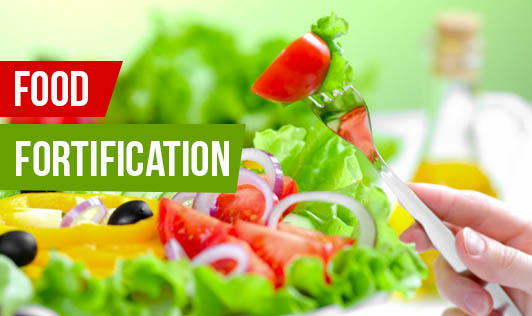


Food nutritional fortification substances refer to natural or artificial nutrients and other nutritional components added to food to increase the nutrition content (value). "Food Safety Law of the People's Republic of China" classifies nutritional fortification substances as food additives.
In China, the use of food nutritional fortification substances needs to meet the requirements of the "National Food Safety Standard - Standard for Use of Food Nutrition Fortifiers" (GB 14880-2012). This standard is mandatory. If manufacturers use nutritional fortifiers in food, they must meet the relevant requirements of this standard. However, manufacturers can voluntarily choose whether to fortify the corresponding nutrients in food.
Foodmate briefly introduces the labeling and using requirements of food nutritional fortification substances.
1. Labeling of nutritional fortification substances in food ingredient lists
(1) Manufacturers can choose any of the following three methods to label food nutritional fortification substances in the ingredient list:
(a) Label the name of the compound, according to the name under the source of the compound in Appendix B or Table C.1 of GB 14880.
For example, if a food is fortified with vitamin E and the compound used is dl-α-tocopherol, "dl-α-tocopherol" can be labeled in the ingredient list.
(b) Label the name of the food nutritional fortification substance and the compound name at the same time.
For example, if a food is fortified with vitamin E and the compound source is dl-alpha-tocopherol, which can be labeled as "vitamin E (dl-alpha-tocopherol)" or "dl-alpha-tocopherol (vitamin E) " in the ingredient list.
(c) Label the name of the food nutritional fortification substance.
For example, a food is fortified with vitamin E, "vitamin E" can be labeled in the ingredient list.
In accordance with the internationally accepted labeling methods, manufacturers are encouraged to use (a) and (b) methods for labeling the ingredient list.
(2) Equivalent names in parentheses in GB 14880 can be used.
Equivalent names are indicated in parentheses following the source of certain nutritional fortification compounds and substances, and either or both of the names can be labeled on the product label.
For example, "Niacin (nicotinic acid)" can be labeled as "Niacin ", "nicotinic acid" or "Niacin (nicotinic acid)".
(3) Fortified vitamins and minerals can be classified and labeled.
For example, vitamins (retinyl palmitate, calcium D-pantothenate…), minerals (calcium carbonate, magnesium chloride…).
2. Nutritional components indicated in the Nutrition Information
According to the requirements of "National Food Safety Standard - General Standard for the Nutritional Labeling of Prepackaged Foods" (GB 28050-2011), prepackaged foods with food nutrition enhancers, the contents of the nutritional components and percentages of Nutrient Reference Value (NRV) in foods after using nutritional enhancement shall be listed in the Nutrition Information.
(a) The usage amount of food nutritional fortification substance specified in Appendix A of GB 14880 refers to the actual amount added during the production process, not equivalent to the nutrient content in Nutrition Information. Because the content of various nutrients contained in the background levels of different food raw materials is quite different, the attenuation and loss of different nutrients during product production and shelf-life are also different. Therefore, there may be inconsistencies between the indicated value and the detected value, and there may be situations where the indicated value is higher or lower than the nutrient usage range specified in GB 14880.
(b) When labeling other nutrient components that are allowed to be fortified in GB14880 and the announcement of the national health administrative department, except those listed in Table 1 of GB 28050, the order should be after the nutrients listed in Table 1 of GB 28050.
For example, a product is fortified with both vitamin A and L-carnitine, vitamin A is listed in Table 1 of GB 28050, but L-carnitine is not. Therefore, in the Nutrition Information, vitamin A should be ranked higher than L-carnitine.
3. Conversion of the amount of nutrients used
Since the usage amount of food nutritional fortification substance refers to the usage amount of the active ingredient in the compound source, some compounds need to be converted to determine the usage amount.
Example, to fortify the nutrient iron in bread. If ferrous gluconate is used as the source of the compound to strengthen the nutrient, it is necessary to combine the chemical formula of the ferrous gluconate compound used to calculate the relative molecular mass of ferrous gluconate. Then, according to the percentage of the relative molecular mass of iron in the relative molecular mass of the compound, and the total amount of the compounds required for the nutritional fortifier "iron" in the corresponding category of food to reach the amount specified in GB14880 was calculated.
The molecular formula for ferrous gluconate: C12H22FeO14·nH2O, n=0 or 2.For example, when n=0, it means that ferrous gluconate anhydrous is selected. The relative molecular mass of ferrous gluconate anhydrous is 446.15, and the relative molecular mass of the iron element is 56. According to GB 14880, the dosage of fortified iron in bread is 14mg/kg~26mg/kg. Therefore, the theoretical range of ferrous gluconate usage: (446.15×14mg/kg)/56~(446.15×26mg/kg)/56=111.54mg/kg~207.14mg/kg.
Conclusion: When using food nutritional fortification substances to fortify foods, it is necessary to pay attention to the types of foods that can be fortified, the amount used, the compound source allowed to be used, and pay attention to the conversion of the amount of use, and avoid using food nutritional fortification substances beyond the scope. At the same time, foods with food nutrition enhancers should truthfully and correctly indicate the fortified nutrient content value and NRV% in the Nutrition Information, so as to convey the necessary nutrient composition information to consumers.
Need help or have a question?
Send mail